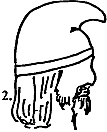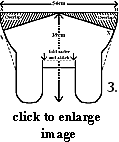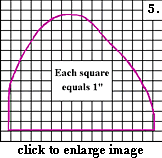The Phrygian Cap
The Phrygian cap is a sort of cross between a close-fitting cap and a hood, sometimes more one than the other. It was worn by the ancient Greeks, the Scythians, the Gauls, the Franks, the Anglo-Saxons and the French revolutionaries in the late 1700's.
You can make a 'down and dirty' Phrygian cap by taking a modern toboggan in an appropriately subtle color, stretching it out to it's fullest and then sewing a band of trim around he head opening. When you put it on, pull the point of the cap toward the front of the head (Fig. 1). Another easy way to construct one is to buy one of those felt 'hillbilly' hats from an Ozark or Smokey Mountain tourist traps. Cut off the brim, sew on some trim around the head opening and then wet the felt with a spray bottle. When the felt is damp, pull the point of the cap forward and pin in place from the inside of the cap. Allow to dry and remove the pins (Fig. 2). You can also steam it in pace if you have the equipment and technology.
But you wanted to make one yourself, didn't' you? There is an extant cap from Duro-Europas (modern Syria) from around 250 A.D. It was made of cloth and was woven to shape on a loom. Figure 3 gives the pattern. To construct, overlap the front edge matching points A with X and B with Y (Fig. 4). This cap had blanket stitching on all of the edges. The pendants in the back were decorated with loops of thread, rather like punch needle work. It was lined with felt.
The Scythians used a similar pattern for their leather caps. For the Scythian cap use the alternate cutting line (_._._._._). If you are using leather, make sure it is soft and supple or you will look like you are wearing a dunce hat with a cape (rather like a KKK member).
The Gaulish, Frankish and Anglo-Saxon caps lacked the pendants or capes of the earlier caps. Figure 5 shows a pattern for the average male head (61cm in circumference). Cut two pieces and sew them together. Turn the head opening under 1½" and stitch down to the inside of the cap. Trim the edge with braid or trim.
Sources:
Cernaenko, E.V. The Scythians. Osprey Men-At-Arms series #137, 1983.
The Excavations at Dura-Europos. Final Report IV, Part II, The Textiles. Yale University Press, 1945.
Lester, Katherine Morris and Oerke, Bess Viola Accessories of Dress. Charles A. Bennett, 1940.

Back to Early Period #6 |
Back to Early Period Index |
Back to PastTimes













